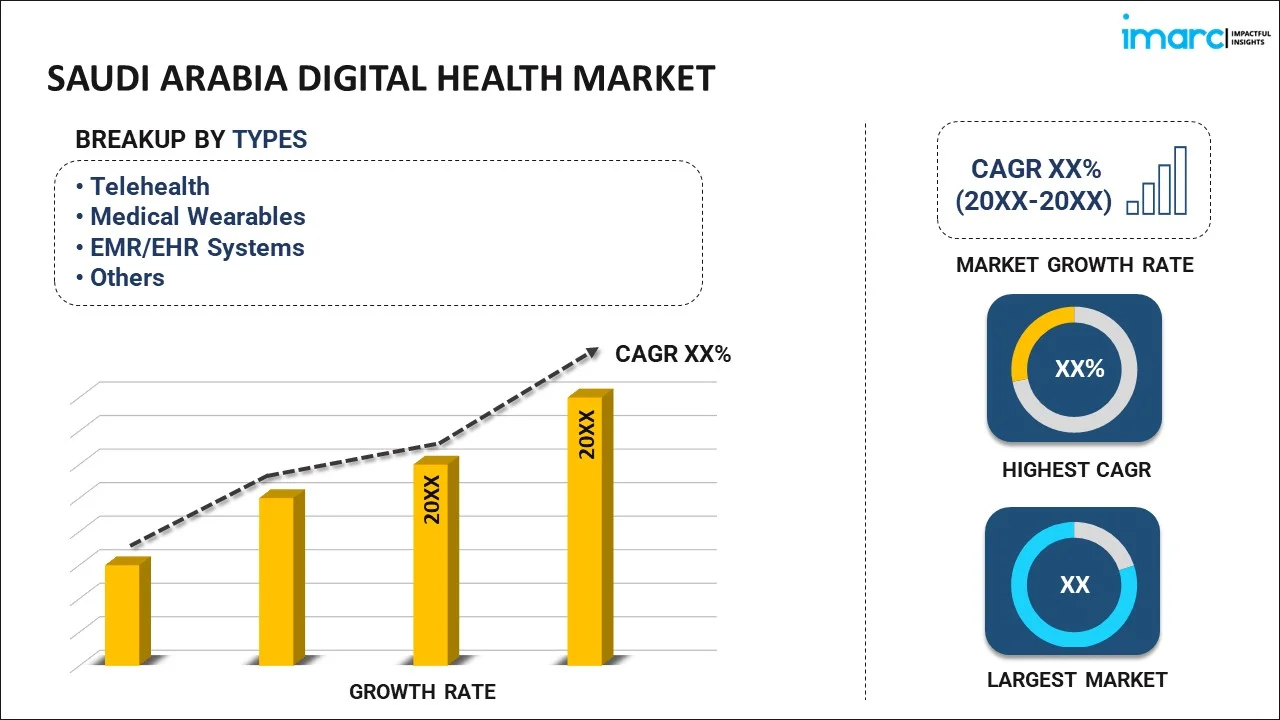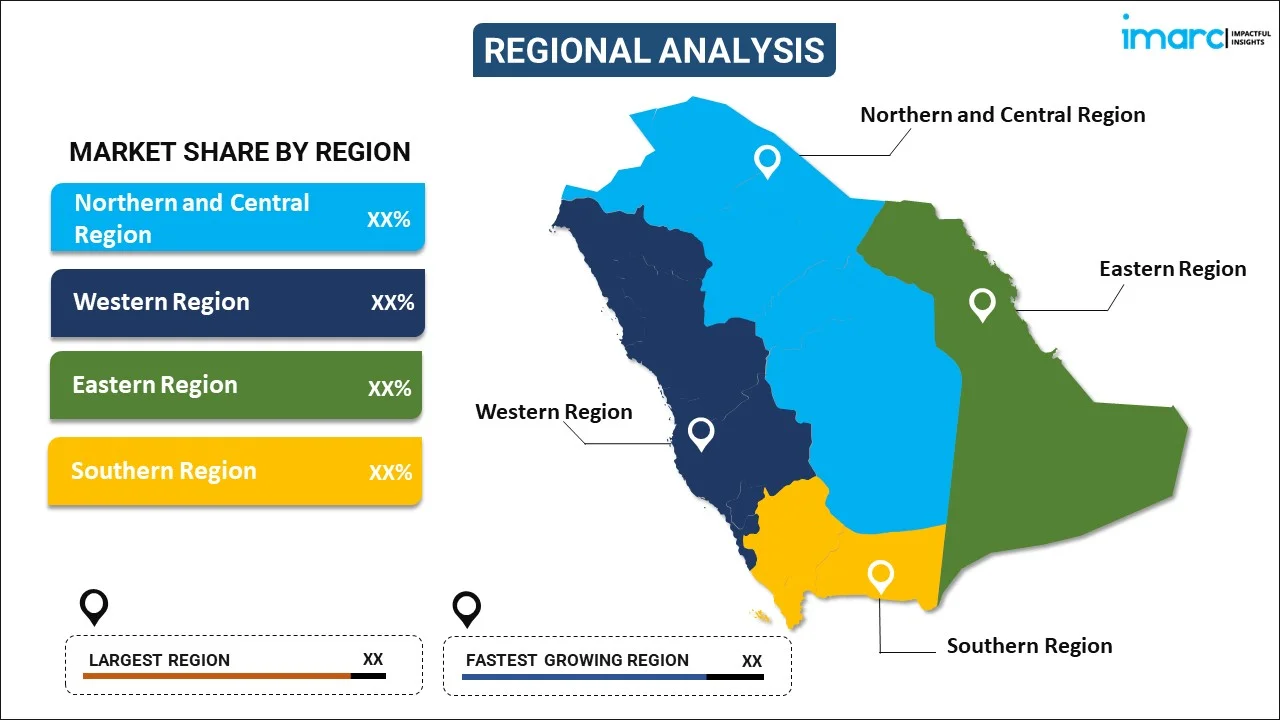
Saudi Arabia Digital Health Market Report by Type (Telehealth, Medical Wearables, EMR/EHR Systems, Medical Apps, Healthcare Analytics, and Others), Component (Software, Hardware, Service), and Region 2025-2033
Market Overview:
Saudi Arabia digital health market size reached USD 4.4 Billion in 2024. Looking forward, IMARC Group expects the market to reach USD 15.3 Billion by 2033, exhibiting a growth rate (CAGR) of 13.20% during 2025-2033. The growing prevalence of chronic diseases like diabetes and cardiovascular conditions, rising utilization of mHealth apps and online platforms by patients, and increasing digitization of healthcare processes and data represent some of the key factors driving the market.
|
Report Attribute
|
Key Statistics
|
|---|---|
|
Base Year
|
2024
|
|
Forecast Years
|
2025-2033
|
|
Historical Years
|
2019-2024
|
|
Market Size in 2024
|
USD 4.4 Billion |
|
Market Forecast in 2033
|
USD 15.3 Billion |
| Market Growth Rate 2025-2033 | 13.20% |
Digital health refers to the use of digital tools, technologies, and data to improve healthcare delivery and patient outcomes. It encompasses a wide array of applications, such as electronic health records (EHRs), mobile health (mHealth) apps, wearable devices, telemedicine, and health analytics. It is created through the collaboration of healthcare professionals, software engineers, and data scientists who develop, refine, and deploy these technologies. It can be categorized into various types, including clinical, administrative, and consumer-focused solutions. It ensures access to healthcare services, especially in remote or underserved areas. It also streamlines administrative tasks, reduces paperwork, and enhances the speed of healthcare delivery. It fosters preventive care by enabling early detection of health issues and promotes better management of chronic conditions. It allows medical research by providing vast datasets for analysis, leading to advancements in healthcare practices. It provides patients with improved convenience through remote consultations and real-time monitoring.
Saudi Arabia Digital Health Market Trends:
At present, the increasing digitization of healthcare processes and data due to the implementation of EHRs, which enable healthcare providers to store, access, and share patient information electronically, represents one of the key factors impelling the growth of the market in Saudi Arabia. The digitization of health records enhances the efficiency of healthcare delivery, reduces errors, and facilitates data-driven decision-making. Additionally, the growing emergence of telehealth services that allow patients to consult with healthcare professionals remotely, thereby improving access to medical care, especially in rural and underserved areas, is offering a favorable market outlook in the country. The advent of remote monitoring technologies, such as wearable devices, is becoming increasingly popular for tracking vital signs and managing chronic conditions, contributing to better patient outcomes. Apart from this, rising investments in healthtech startups is leading to innovative solutions, such as mHealth apps and artificial intelligence (AI)-powered diagnostic tools, to address various healthcare challenges. The governing body and private investors are providing funds and support to nurture these startups, fostering innovation. In addition, the increasing utilization of mHealth apps and online platforms by patients to access health information, schedule appointments, and manage their health records is supporting the market growth in the country. Furthermore, the growing prevalence of chronic diseases like diabetes and cardiovascular conditions requires digital health solutions for managing and monitoring these conditions. Besides this, the rising employment of data analytics and AI for enabling healthcare organizations to derive insights from large datasets, predict disease trends, and personalize treatment plans is bolstering the market growth in the country. These AI-powered diagnostic tools assist in early disease detection, enhancing the accuracy and speed of diagnosis.
Saudi Arabia Digital Health Market Segmentation:
IMARC Group provides an analysis of the key trends in each segment of the market, along with forecasts at the country levels for 2025-2033. Our report has categorized the market based on type and component.
Type Insights:

- Telehealth
- Medical Wearables
- EMR/EHR Systems
- Medical Apps
- Healthcare Analytics
- Others
The report has provided a detailed breakup and analysis of the market based on the type. This includes telehealth, medical wearables, EMR/EHR systems, medical apps, healthcare analytics, and others.
Component Insights:
- Software
- Hardware
- Service
A detailed breakup and analysis of the market based on the component have also been provided in the report. This includes software, hardware, and service.
Regional Insights:

- Northern and Central Region
- Western Region
- Eastern Region
- Southern Region
The report has also provided a comprehensive analysis of all the major regional markets, which include Northern and Central Region, Western Region, Eastern Region, and Southern Region.
Competitive Landscape:
The market research report has also provided a comprehensive analysis of the competitive landscape in the market. Competitive analysis such as market structure, key player positioning, top winning strategies, competitive dashboard, and company evaluation quadrant has been covered in the report. Also, detailed profiles of all major companies have been provided.
Saudi Arabia Digital Health Market Report Coverage:
| Report Features | Details |
|---|---|
| Base Year of the Analysis | 2024 |
| Historical Period | 2019-2024 |
| Forecast Period | 2025-2033 |
| Units | Billion USD |
| Scope of the Report | Exploration of Historical and Forecast Trends, Industry Catalysts and Challenges, Segment-Wise Historical and Predictive Market Assessment:
|
| Types Covered | Telehealth, Medical Wearables, EMR/EHR Systems, Medical Apps, Healthcare Analytics, Others |
| Components Covered | Software, Hardware, Service |
| Regions Covered | Northern and Central Region, Western Region, Eastern Region, Southern Region |
| Customization Scope | 10% Free Customization |
| Post-Sale Analyst Support | 10-12 Weeks |
| Delivery Format | PDF and Excel through Email (We can also provide the editable version of the report in PPT/Word format on special request) |
Key Questions Answered in This Report:
- How has the Saudi Arabia digital health market performed so far and how will it perform in the coming years?
- What has been the impact of COVID-19 on the Saudi Arabia digital health market?
- What is the breakup of the Saudi Arabia digital health market on the basis of type?
- What is the breakup of the Saudi Arabia digital health market on the basis of component?
- What are the various stages in the value chain of the Saudi Arabia digital health market?
- What are the key driving factors and challenges in the Saudi Arabia digital health?
- What is the structure of the Saudi Arabia digital health market and who are the key players?
- What is the degree of competition in the Saudi Arabia digital health market?
Key Benefits for Stakeholders:
- IMARC’s industry report offers a comprehensive quantitative analysis of various market segments, historical and current market trends, market forecasts, and dynamics of the Saudi Arabia digital health market from 2019-2033.
- The research report provides the latest information on the market drivers, challenges, and opportunities in the Saudi Arabia digital health market.
- Porter's five forces analysis assist stakeholders in assessing the impact of new entrants, competitive rivalry, supplier power, buyer power, and the threat of substitution. It helps stakeholders to analyze the level of competition within the Saudi Arabia digital health industry and its attractiveness.
- Competitive landscape allows stakeholders to understand their competitive environment and provides an insight into the current positions of key players in the market.
Need more help?
- Speak to our experienced analysts for insights on the current market scenarios.
- Include additional segments and countries to customize the report as per your requirement.
- Gain an unparalleled competitive advantage in your domain by understanding how to utilize the report and positively impacting your operations and revenue.
- For further assistance, please connect with our analysts.
 Inquire Before Buying
Inquire Before Buying
 Speak to an Analyst
Speak to an Analyst
 Request Brochure
Request Brochure
 Request Customization
Request Customization




.webp)




.webp)












